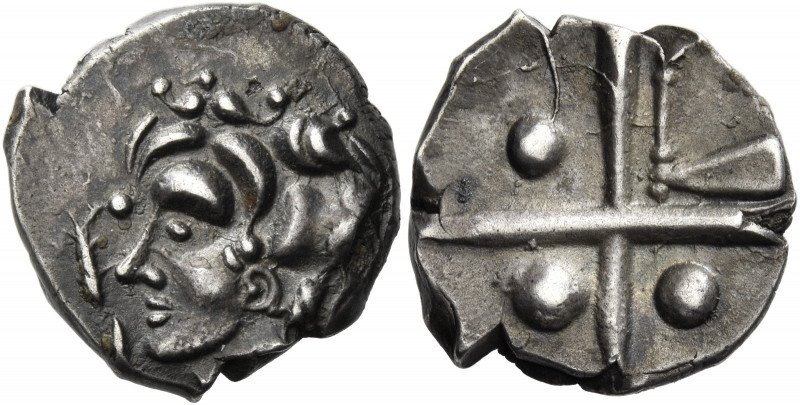The Hidden Power of Ancient Celtic Coins
Art, Identity & the Legacy of a Forgotten People
Who Were the Celts — and Why Their Coins Matter
The Celts didn’t leave us libraries or marble temples. What they left behind were weapons, artwork, and coins — and if you ask me, their coins say more about them than any scroll ever could.
Celtic tribes roamed Europe long before Rome was an empire. From the windswept hills of Britain to the forests of Gaul, these people built vibrant societies full of warriors, artisans, mystics — and yes, minters.
Their coins? They weren’t just money. They were art, power, religion, and resistance — all wrapped into something small enough to fit in your palm.
Celtic Coins: More Than Just Trade Tools
Let me be clear: Celtic coins are wild.
Where Greek coins are refined and Roman ones are imperial, Celtic coins feel alive — sometimes chaotic, always imaginative. You’ll see horses mid-gallop, spirals that swirl like wind, and faces that seem half-human, half-god.
These coins weren’t trying to impress foreign traders — they were made by Celts, for Celts, reflecting their view of the world.
A Collector’s Look at Celtic Design
Unlike the realism of Roman coins, Celtic designs lean abstract — almost spiritual.
🔹 Horses gallop across many coins, full of energy. For the Celts, horses were sacred: symbols of freedom, warfare, and divine strength.
🔹 Boars appear too — often stylized like storm clouds with tusks. These animals stood for courage and ferocity in battle.
🔹 Geometric patterns like spirals, swirls, and crescents repeat across different tribes — not just decorations, but symbols with meaning (possibly lunar or solar).
What I love most: Every Celtic coin feels handmade. No two are identical. You’re not just buying history — you’re buying expression.
Regional Styles (and What They Reveal)
Because the Celts weren’t a single unified empire, their coins vary hugely by region. That’s part of the thrill.
🏹 Gaul (Modern France)
-
Often inspired by Macedonian coins from Philip II and Alexander.
-
You’ll see heads of deities twisted into something unmistakably Celtic.
🐎 Britain
-
Abstract to the max. Some coins barely resemble what they started from — and that’s the point.
-
Symbols like horses, wheels, and stars dominate.
🌄 Iberia (Spain)
-
Blend of native Celtic and Iberian influence.
-
Regional gods, scripts, and animal motifs you won’t find anywhere else.
How Coins Help Us Understand the Celtic World
Here’s the thing: the Celts didn’t write down their history. Much of what we know about them comes from outsiders — mostly Romans — who weren’t exactly unbiased.
So when you hold a Celtic coin, you’re holding a rare direct voice from the Celts themselves.
Coins reveal:
-
Which tribes ruled where (many coins carry tribal names or symbols)
-
Political power — only powerful chieftains minted coins
-
Economic structure — coins show a move from barter to trade networks
-
Religious beliefs — the symbols weren’t random; they were intentional
Some coins were minted in times of war. Others during prosperity. Some likely used in ceremonies. The mystery adds to the magic.
The Reality of Collecting Celtic Coins
Let’s talk collector truth: Celtic coins aren’t easy.
✅ What makes them great:
-
Every coin is unique
-
They’re older than most Roman types
-
The designs are deeply artistic
-
Some gold Celtic coins are breathtakingly beautiful — and rare
⚠️ What to watch out for:
-
Fakes — Sadly, the abstract style makes them easier to counterfeit. Only buy from trusted dealers.
-
Condition — Many come corroded or misstruck. Don’t expect perfection.
-
Price — Scarcity + demand = high value, especially for gold or iconic types
But when you find a genuine one? It’s unforgettable. You’ll feel like you’ve uncovered a piece of tribal Europe, raw and unfiltered.
How to Spot a Real Celtic Coin
No two coins are identical, but there are patterns to look for:
✔️ Design elements — Look for horses, heads, swirls, and moons
✔️ Metal — Bronze, silver, and especially gold were common
✔️ Size & shape — Often irregular, thicker, and smaller than Greek or Roman coins
✔️ Weight — Don’t trust it alone — but it helps when comparing known types
🧠 Best move? When in doubt, consult experts. Use resources like Wildwinds, ForumAncientCoins, or get grading done through NGC Ancients.
Why Celtic Coins Still Inspire Today
Celtic coins have been rediscovered again and again — not just by archaeologists, but by modern designers.
-
Jewelry makers draw inspiration from the spirals and warriors.
-
Tattoo artists adapt symbols like triskele and solar wheels.
-
Game designers and filmmakers use them as props of mystery and legend.
These coins live on — not just in museums, but in the modern imagination.
My Personal Take
I’ve been collecting for years — Roman, Greek, Byzantine — but Celtic coins hit different.
They don’t tell you everything. They make you ask questions.
They’re not perfect. That’s the point.
And when you finally learn to read their symbols, it’s like unlocking a forgotten language.
Whether you’re chasing a British gold stater or a chunky Gaulish bronze, one thing’s certain: you’re holding something raw, honest, and deeply human.
Ready to Start?
Celtic coins aren’t the easiest to collect — but they’re among the most rewarding.
👉 Want help starting your Celtic collection? Visit NumisDon.com for handpicked coins, collecting tips, and resources tailored for history lovers and collectors.
